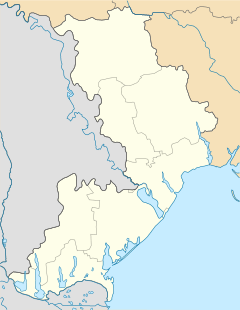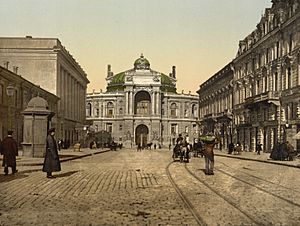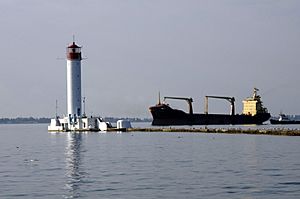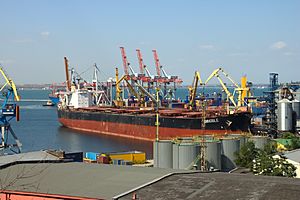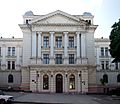Odessa facts for kids
Quick facts for kids
Odessa
|
|||||
|---|---|---|---|---|---|
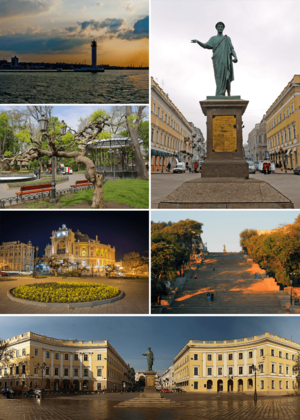
Counterclockwise: Monument to the Duc de Richelieu, Vorontsov Lighthouse, City garden, Opera and Ballet Theatre, Potemkin Stairs, Square de Richelieu
|
|||||
|
|||||
| Country | |||||
| Oblast | |||||
| Municipality | Odessa Municipality | ||||
| Port founded | 2 September 1794 | ||||
| Area | |||||
| • Total | 236.9 km2 (91.5 sq mi) | ||||
| Elevation | 40 m (130 ft) | ||||
| Highest elevation | 65 m (213 ft) | ||||
| Lowest elevation | −4.2 m (−14 ft) | ||||
| Population
(2015)
|
|||||
| • Total | 1,016,515 | ||||
| • Density | 4,290.9/km2 (11,113.4/sq mi) | ||||
| Demonym(s) | English: Odessite Ukrainian: одесит, одеситка Russian: одессит, одесситка |
||||
| Time zone | UTC+2 (EET) | ||||
| • Summer (DST) | UTC+3 (EEST) | ||||
| Postal code |
65000–65480
|
||||
| Area code(s) | +380 48 | ||||
| Website | www.omr.gov.ua/en/ | ||||
| 1Metropolitan area population as of 2001 | |||||
Odessa (Ukrainian: Одесcа, also referred to as Odessa) is a city in southwestern Ukraine. It is the administrative center of the Odessa Oblast (province), and is its own separate district within the oblast. Odessa is a major port on the Black Sea.
In 2004, about 1,012,500 people lived in Odessa.
Contents
Overview
A very old Greek colony named Olbia (Greek: Ολβία, glorious) probably was where the city is now. Many monuments from old times link this place to the Eastern Mediterranean. In the Middle Ages these lands were a part of the Kievan Rus, Galich and Volyn Principality, the Golden Horde, the Great Lithuanian Principality, the Crimean Khanate and the Ottoman Empire. Crimean Tatars traded there in the 14th century. At the time of the Russian–Turkish wars these lands were captured by Russia. That was at the end of the 18th century.
From 1819–1858 Odessa was a free port (porto franco). During the Soviet time it was the most important port of trade in the U.S.S.R. and a Soviet naval base. On January 1, 2000 the Quarantine Pier of Odessa trade sea port was made a free port and free economic zone for 25 years.
Odessa is a warm water port, but of small military value. Because Turkey controls the Dardanelles and Bosphorus, NATO can control ships moving between Odessa and the Mediterranean Sea. The city of Odessa has two important ports: Odessa itself and Yuzhny. Yuzhny is an oil terminal that is important to the world. It is in Odessa's suburbs. Another important port, Illichivs'k (or Ilyichyovsk), is in the same oblast, to the south-west of Odessa. Important transportation comes together at these ports. Railways and pipelines come to these ports. Pipelines connect Odessa's oil and chemical factories to Russia's and the EU's.
Odessa is the fifth-largest city in Ukraine and its most important trading city. In the 19th century it was the fourth city of Imperial Russia, after Moscow and St. Petersburg, and Warsaw. Its old buildings seem more Mediterranean than Russian. They were made like French and Italian buildings. People in Odessa could always laugh and had a spirit of freedom. The reason is probably because Odessa is a nice place and because the people accept others. They let others be the kind of people that they are.
History

From the start of Odessa to the end of the 19th century
In the 15th century AD, nomadic tribes of the Nogays under the government of the Khanate of Crimea lived in the place that is now Odessa. During the reign of Khan Haci I Giray, the Khanate was in danger because the Golden Horde and the Ottoman Turks were not friends of the Khanate. To get help, the khan gave Odessa to the Grand Duchy of Lithuania. The place now named Odessa was then named Khadjibey (also spelled as Khadjibei, Khadzhibei, or Gadzhibei; Lithuanian: Chadžibėjus; Crimean Tatar and Turkish: Hacibey). It was part of the Dykra region. Few people lived in that region. They were part of the Turkic tribes. The land was mostly empty steppes.
The Ottoman Empire controlled Khadjibey after 1529. The region surrounding Khadjibey was named Yedisan. The Ottoman Empire controlled that region as part of Silistra (Özi) Province. In the middle of the 18th century, the Ottomans rebuilt a fortress at Khadjibey. It was named Eni Dunia (Turkish: Yeni Dünya, literally "new world").
At the time of the war between Russia and Turkey (1787–1792), on 25 September 1789, Ivan Gudovich led a group of Russian soldiers to Khadjibey. They took Khadjibey and Yeni Dünya for the Russian Empire. A Spaniard in the Russian army named Major General José de Ribas led one group of soldiers. Russians named him Osip Mikhailovich Deribas. The main street in Odessa today is named Deribasovskaya street after him. Turkey let Russia keep the city in the Treaty of Jassy (agreement of Jassy) in 1792. Russians made it a part of a place they named Novorossiya (New Russia).
The Russian government decided to build a naval fortress on the ruins of Khadjibey city in 1794. This became the city named Odessa by January 1795. In that year its new name was first written in government letters. The reasons for the new name are lost but people guess why Odessa got a new name. According to one of the stories, when someone said Odessos should be the name for the new Russian port, Catherine II said that all names in the South of the Empire were already 'masculine,' and she did not want another one, so she decided to change it to more 'feminine' Odessa. This story may be false. There were at least two cities (Eupatoria and Theodosia) with names that sound 'feminine' for a Russian; also, Catherine II did not speak Russian when she was a child, and lastly, all cities are feminine in Greek (and in Latin). Another story is that the name 'Odessa' is from word-play in French. French was then the language spoken at the Russian court. 'Plenty of water' is assez d'eau in French. If one says this backwards, it sounds like the Greek colony's name. Word-play about water makes sense. Odessa is next to a very big body of water but has a little fresh water. Anyhow, there is still a link with the name of the old Greek colony. So there may be some truth in the things people said long ago.
The new city quickly became a major success. Its early growth owed much to the work of the Duc de Richelieu, who served as the city's governor between 1803–1814. Having fled the French Revolution, he had served in Catherine's army against the Turks. He is credited with designing the city and organising its amenities and infrastructure, and is considered one of the founding fathers of Odessa, together with another Frenchman, Count Alexandre Langeron, who succeeded him in office. Richelieu is commemorated by a bronze statue, unveiled in 1828 to a design by Ivan Martos.
In 1819 the city was made a free port, a status it retained until 1859. It became home to an extremely diverse population of Russians, Ukrainians, Jews, Greeks, Bulgarians, Albanians, Armenians, Italians, Frenchmen, Germans and traders representing many other European nationalities (hence numerous 'ethnic' names on the city's map, e.g., Frantsuszkiy (French) and Italianskiy (Italian) Boulevards, Grecheskaya (Greek), Evreyskaya (Jewish), Arnautskaya (Albanian) Streets). Its cosmopolitan nature was documented by the great Russian poet Alexander Pushkin, who lived in internal exile in Odessa between 1823–1824. In his letters he wrote that Odessa was a city where "you can smell Europe. French is spoken and there are European papers and magazines to read".
Odessa's growth was interrupted by the Crimean War of 1853–1856, during which it was bombarded by British and French naval forces. It soon recovered and the growth in trade made Odessa Russia's largest grain-exporting port. In 1866 the city was linked by rail with Kiev and Kharkov as well as Iaşi, Romania.
The city became the home of a large Jewish community during the 19th century, and by 1897 Jews were estimated to be about 37% of the population. They were, however, repeatedly subjected to severe persecution. Pogroms were carried out in 1821, 1859, 1871, 1881, and 1905. Many Odessan Jews fled abroad, particularly to Palestine after 1882, and the city became an important base of support for Zionism.
First half of the 20th century
In 1905 Odessa was the place of a workers' uprising supported by the crew of the Russian battleship Potemkin (also see Battleship Potemkin uprising) and Lenin's Iskra. Sergei Eisenstein's famous motion picture The Battleship Potemkin commemorated the uprising and included a scene where hundreds of Odessan citizens were killed on the great stone staircase (now popularly known as the "Potemkin Steps"), in one of the most famous scenes in motion picture history. At the top of the steps, which lead down to the port, stands a statue of Richelieu. The actual massacre took place in streets nearby, not on the steps themselves, but the movie caused many to visit Odessa to see the site of the "slaughter". The "Odessa Steps" continue to be a tourist attraction in Odessa. The film was made at Odessa's Cinema Factory, one of the oldest cinema studios in the former Soviet Union.
Following the Bolshevik Revolution in 1917 during World War I, Odessa was occupied by several groups, including the Ukrainian Tsentral'na Rada, the French Army, the Red Army and the White Army. Finally, in 1920, the Red Army took control of Odessa and united it with the Ukrainian SSR, which later became part of the USSR.
The people of Odessa suffered from a great famine that occurred in 1921–1922 as a result of the war. During World War II Odessa was occupied by Romanian and German forces from 1941–1944. The city suffered severe damage and many casualties.
Under the Axis occupation, approximately 60,000 Odessans (mostly Jews) were either massacred or deported. Many parts of Odessa were damaged during its fall and later recapture in April 1944, when the city was finally liberated by the Soviet Army. It was one of the first four Soviet cities to be awarded the title of "Hero City" in 1945.
Second half of the 20th century
During the 1960s and 1970s the city grew tremendously. Nevertheless, between the 1970s and 1990s, the majority of Odessa's Jews emigrated to Israel, the United States and other Western countries, domestic migrationof Odessan middle and upper classes to Moscow and Leningradthat offered even greater opportunities for career advancement, also occurred on a large scale. But the city's grew rapidly by filling the void with new rural migrants elsewhere from Ukraine, industrial professionals invited from Russia as well as other Soviet republics. Despite being part of Ukraine Socialist Republic, the city preserved and somewhat reinforced its unique cosmopolitan mix of Russian/Ukrainian/Mediterranean culture and a predominantly Russophone environment with a uniquely accented dialect of Russian spoken in the city. The city's Russian, Ukrainian, Greek, Armenian, Moldovan and Azeri and Jewish communities have influenced different aspects of Odessa.

In 1991, after the collapse of Communism, the city became part of newly independent Ukraine. Today Odessa is a city of around 1.1 million people. The city's industries include shipbuilding, oil refining, chemicals, metalworking and food processing. Odessa is also a Ukrainian naval base and home to a fishing fleet. It is also known for its huge outdoor market, the Seventh-Kilometer Market.
The transportation network of Odessa consists of trams (streetcars), trolleybuses, buses; and marshrutkas.
Geography
Odessa is situated on terraced hills overlooking a small harbor on the Black Sea in the Gulf of Odessa, approximately 31 km (19 mi) north of the estuary of the Dniester river and some 443 km (275 mi) south of the Ukrainian capital Kiev. The average elevation at which the city is located is around 50 metres (160 feet), while the maximum is 65 metres (213 feet) and minimum (on the coast) amounts to 4.2 metres (13.8 feet) above sea level. The city currently covers a territory of 163 km2 (63 sq mi), the population density for which is around 6,139 persons/km². Sources of running water in the city include the Dniester River, from which water is taken and then purified at a processing plant just outside the city. Being located in the south of Ukraine, the topography of the area surrounding the city is typically flat and there are no large mountains or hills for many kilometres around. Flora is of the deciduous variety and Odessa is known for its tree-lined avenues which, in the late 19th and early 20th centuries, made the city a favourite year-round retreat for the Russian aristocracy.
The city's location on the coast of the Black Sea has also helped to create a booming tourist industry in Odessa. The city's Arkadia beach has long been a favourite place for relaxation, both for the city's inhabitants and its visitors. This is a large sandy beach which is located to the south of the city centre. Odessa's many sandy beaches are considered to be quite unique in Ukraine, as the country's southern coast (particularly in the Crimea) tends to be a location in which the formation of stoney and pebble beaches has proliferated.
The coastal cliffs adjacent to the city are home to frequent landslides, resulting in a typical change of landscape along the Black Sea. Due to the fluctuating slopes of land, city planners are responsible for monitoring the stability of such areas, and for preserving potentially threatened building and other structures of the city above sea level near water. Also a potential danger to the infrastructure and architecture of the city is the presence of multiple openings underground. These cavities can cause buildings to collapse, resulting in a loss of money and business. Due to the effects of climate and weather on sedimentary rocks beneath the city, the result is instability under some buildings' foundations.
Culture

Odessa is a popular tourist destination, with many resorts in and around the city.
The Tolstoy, Vorontsov, and Potocki families owned palaces in Odessa, which can still be visited.
The writer Isaac Babel was born in the city, which has also produced several famous musicians, including the violinists Nathan Milstein, Mischa Elman and David Oistrakh, and the pianists Benno Moiseiwitsch, Sviatoslav Richter and Emil Gilels. The chess player Efim Geller was born in the city. (All listed, except for Richter, are representatives of the city's Jewish community.)
The most popular Russian show-business people from Odessa are Yakov Smirnoff (comedian), Mikhail Zhvanetsky (legendary humorist writer, who began his career as port engineer) and Roman Kartsev (comedian). Their success in 1970s contributed to Odessa's established status of a "capital of Soviet humour". Later several humour festivals were established in the city, including the celebration of the April Fools' Day.
Most of the city's 19th century houses were built of limestone mined nearby. Abandoned mines were later used and broadened by local smugglers. This created a complicated labyrinth of underground tunnels beneath Odessa, known as "catacombs". They are a now a great attraction for extreme tourists. Such tours, however, are not officially sanctioned and are dangerous because the layout of the catacombs has not been fully mapped and the tunnels themselves are unsafe. These tunnels are a primary reason why subway was never built in Odessa.
Demographics
According to the 2001 census, Ukrainians make up a majority (62 percent) of Odessa's inhabitants, along with an ethnic Russian minority (29 percent).
A 2015 study by the International Republican Institute found that 68% of Odessa was ethnic Ukrainian, and 25% ethnic Russian.
Despite Odessa's Ukrainian majority, Russian is the dominant language in the city. In 2015, the main language spoken at home was Russian − around 78% of the total population − followed by Ukrainian at 6%, and an equal combination of Ukrainian and Russian, 15%.
Odessa oblast is also home to a number of other nationalities and minority ethnic groups, including Albanians, Armenians, Azeris, Crimean Tatars, Bulgarians, Georgians, Greeks, Jews, Poles, Romanians, Turks, among others. Up until the early 1940s the city also had a large Jewish population. As the result of mass deportation to extermination camps during the Second World War, the city's Jewish population declined considerably. Since the 1970s, the majority of the remaining Jewish population emigrated to Israel and other countries, shrinking the Jewish community.
Through most of the 19th century and until the mid 20th century, the largest ethnic group in Odessa was Russians, with the second largest ethnic group being the Jews.
Economy
The economy of Odessa largely stems from its traditional role as a port city. The nearly ice-free port lies near the mouths of the Dnieper, the Southern Bug, the Dniester and the Danube rivers, which provide good links to the hinterland.
During the Soviet period (until 1991) the city functioned as the USSR's largest trading port; it continues in a similar role as independent Ukraine's busiest international port. The port complex contains an oil and gas transfer and storage facility, a cargo-handling area and a large passenger port. In 2007 the Port of Odessa handled 31,368,000 tonnes of cargo. The port of Odessa is also one of the Ukrainian Navy's most important bases on the Black Sea. Rail transport is another important sector of the economy in Odessa – largely due to the role it plays in delivering goods and imports to and from the city's port.
Twin towns and sister cities
 Alexandria, Egypt, (since 1968)
Alexandria, Egypt, (since 1968) Baltimore, United States, (since 1975)
Baltimore, United States, (since 1975) Chişinău, Moldova, (since 1994)
Chişinău, Moldova, (since 1994) Constanţa, Romania, (since 1991)
Constanţa, Romania, (since 1991) Gdańsk, Poland
Gdańsk, Poland Genoa, Italy, (since 1972)
Genoa, Italy, (since 1972) Haifa, Israel, (since 1992)
Haifa, Israel, (since 1992) Istanbul, Turkey, (since 1997)
Istanbul, Turkey, (since 1997) Jeddah, Saudi Arabia
Jeddah, Saudi Arabia Kolkata, India, (since 1986)
Kolkata, India, (since 1986) León, Mexico, (since 2012)
León, Mexico, (since 2012) Liverpool, United Kingdom, (since 1957)
Liverpool, United Kingdom, (since 1957) Łódź, Poland, (since 1993)
Łódź, Poland, (since 1993) Marseille, France, (since 1973)
Marseille, France, (since 1973) Nicosia, Cyprus, (since 1996)
Nicosia, Cyprus, (since 1996) Oulu, Finland, (since 1957)
Oulu, Finland, (since 1957) Piraeus, Greece, (since 1993)
Piraeus, Greece, (since 1993) Qingdao, China, (since 1993)
Qingdao, China, (since 1993) Regensburg, Germany, (since 1990)
Regensburg, Germany, (since 1990) Rosh HaAyin, Israel
Rosh HaAyin, Israel Rostov-on-Don, Russia, (since 1999)
Rostov-on-Don, Russia, (since 1999) Split, Croatia, (since 1964)
Split, Croatia, (since 1964) Szeged, Hungary, (since 1977)
Szeged, Hungary, (since 1977) Valencia, Spain, (since 1982)
Valencia, Spain, (since 1982) Van, Turkey
Van, Turkey Vancouver, British Columbia, Canada, (since 1944)
Vancouver, British Columbia, Canada, (since 1944) Varna, Bulgaria (since 1958)
Varna, Bulgaria (since 1958) Yerevan, Armenia (since 1995)
Yerevan, Armenia (since 1995) Yokohama, Japan (since 1968)
Yokohama, Japan (since 1968)
Images for kids
-
The centre of Odesa, with its statue of Catherine the Great, is one of the city's central landmarks.
-
Mikhail Zhvanetsky, 2016
-
Odesa has long been an important Black Sea port
See also
 In Spanish: Odesa para niños
In Spanish: Odesa para niños





